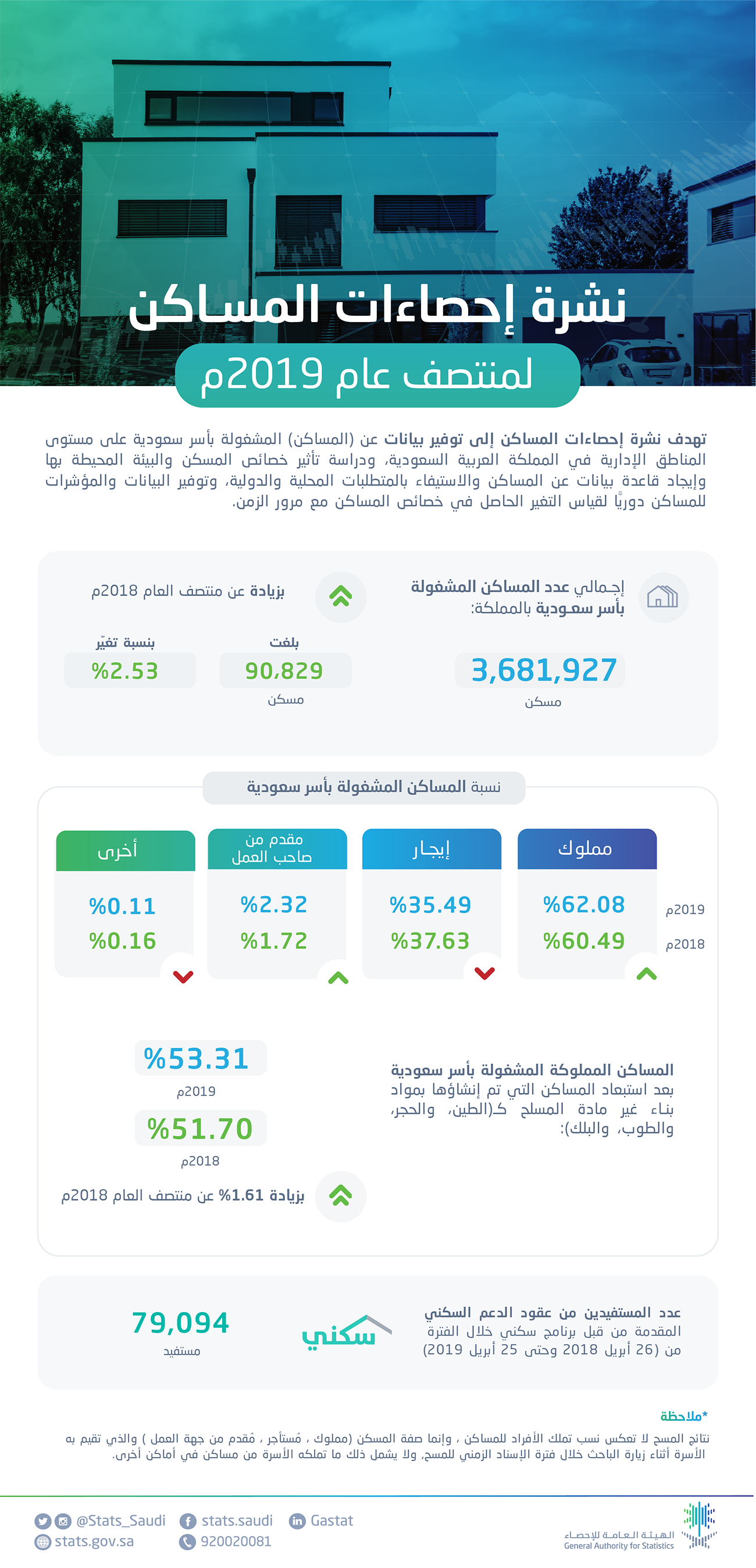Last update 15 / 11 / 2019
GASTAT: the percentage of occupied dwellings of Saudi households increase up to 62.08% and rentals drop to 35.49%

According to the Housing Statistics Bulletin that describes housing realities until the mid of 2019
GASTAT: the percentage of occupied dwellings of Saudi households increase up to 62.08% and rentals drop to 35.49%
On Tuesday 9th of Safar 1440 (October 8th ,2019), GASTAT released the Housing statistics Bulletin on its official website www.stats.gov.sa which combines the results of the field survey, as well as register-based data provided by the Ministry of Housing.
The bulletin aims at providing data of dwellings occupied with Saudi households at Saudi Arabia’s administrative level. Additionally, the bulletin studies the characteristics of dwellings and thier surrounding environment, creates database for dwellings, and meets the local and international requirements as well as the needs of researchers and planners related to dwellings characteristics that are required by developmental plans. The bulletin also provides periodical data and indicators to measure the change in dwellings over time as well as conducting international, regional and local comparisons.
On the other hand, Housing statistics Bulletin showed an increase in the percentage of occupied dwellings in Saudi households out of the total occupied dwellings to (64.85%) until the mid of 2019, compared to (64.17%) by mid of 2018, with (3.681.927) dwellings, which represents an increase compared to (90,829) houses by mid-2018, by a change rate reached (2.53%).
In addition, the bulletin showed that the number of dwellings occupied with Saudi households in Saudi Arabia increased (62.08%) compared to (60.49%) in the middle of 2018, and an increase in the percentage of occupied dwellings occupied by Saudi households ( out of the total occupied dwellings in Saudi households. Moreover, owned dwellings excluding dwellings that were built with “non-reinforced” construction material such as (clay, stone, bricks and block) reached (53.51%) compared to (51.70%) in the middle of 2018. As the results show a reduction in the percentage of occupied rented houses by Saudi households in Saudi Arabia by (35.49%) compared to (37.63%) in the middle of 2018, and an increase in the percentage of housing provided by employers occupied by Saudi households by (2.32%) compared to (1.72%) in the middle of 2018. However, these percentages do not reflect the percentage of individuals who owned dwellings but type of dwelling (owned, rented, employer-provided housing) that may be occupied by household during the visit of the researcher in the reference period of the survey, and do not include owned houses in other places. The results showed that reinforced construction increased by (89.84%) compared to (89.54%) in the mid of 2018. Dwellings occupied with Saudi households and were built with (bricks) decreased by (10.15%) compared to (10.44%) in the mid of 2018.
The results also showed that the majority of dwellings (99.89%) occupied with Saudi households depend on a public network as main source for electricity.
On the other hand, the register-based data of the Ministry of Housing showed the number of beneficiaries of the subsidized housing provided by “Sakani” program which reached (79.641) Saudi households at the administrative level during the period from (April 26th 2018 until April 25th 2019).
